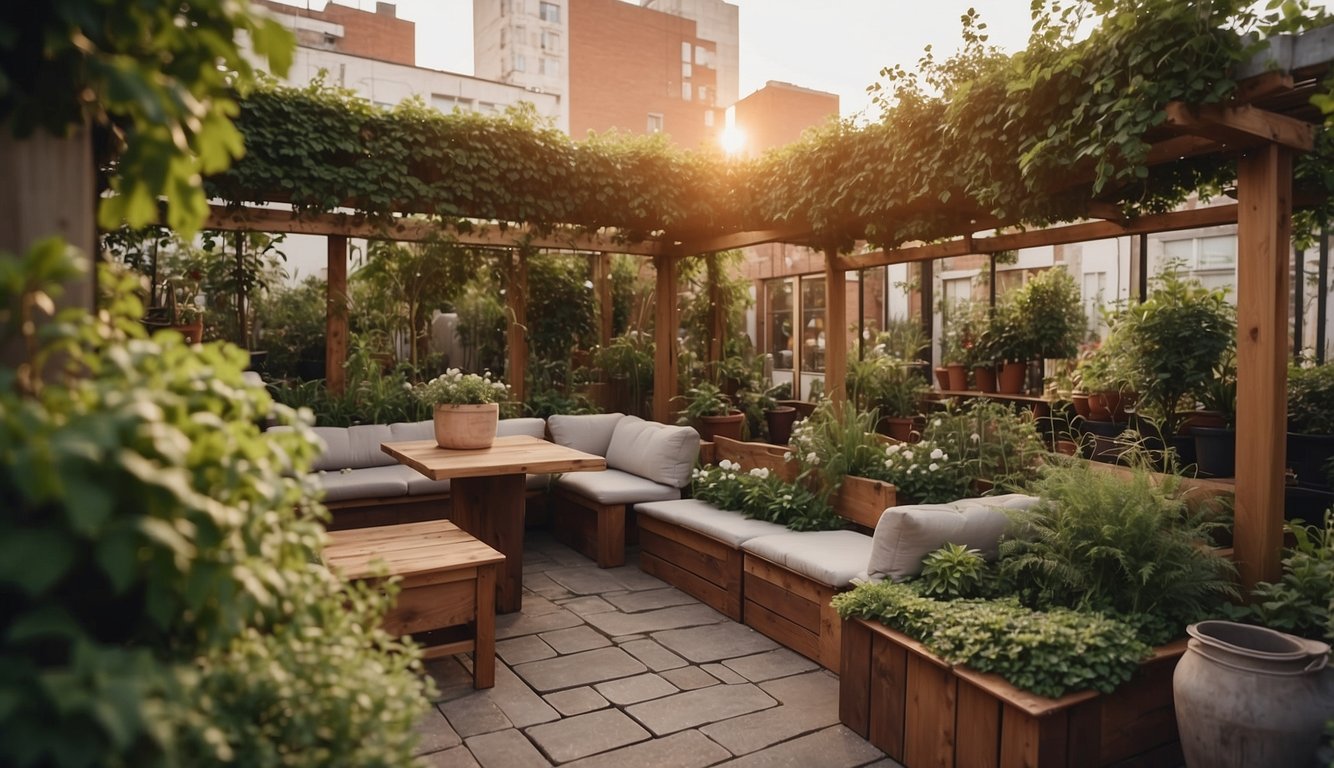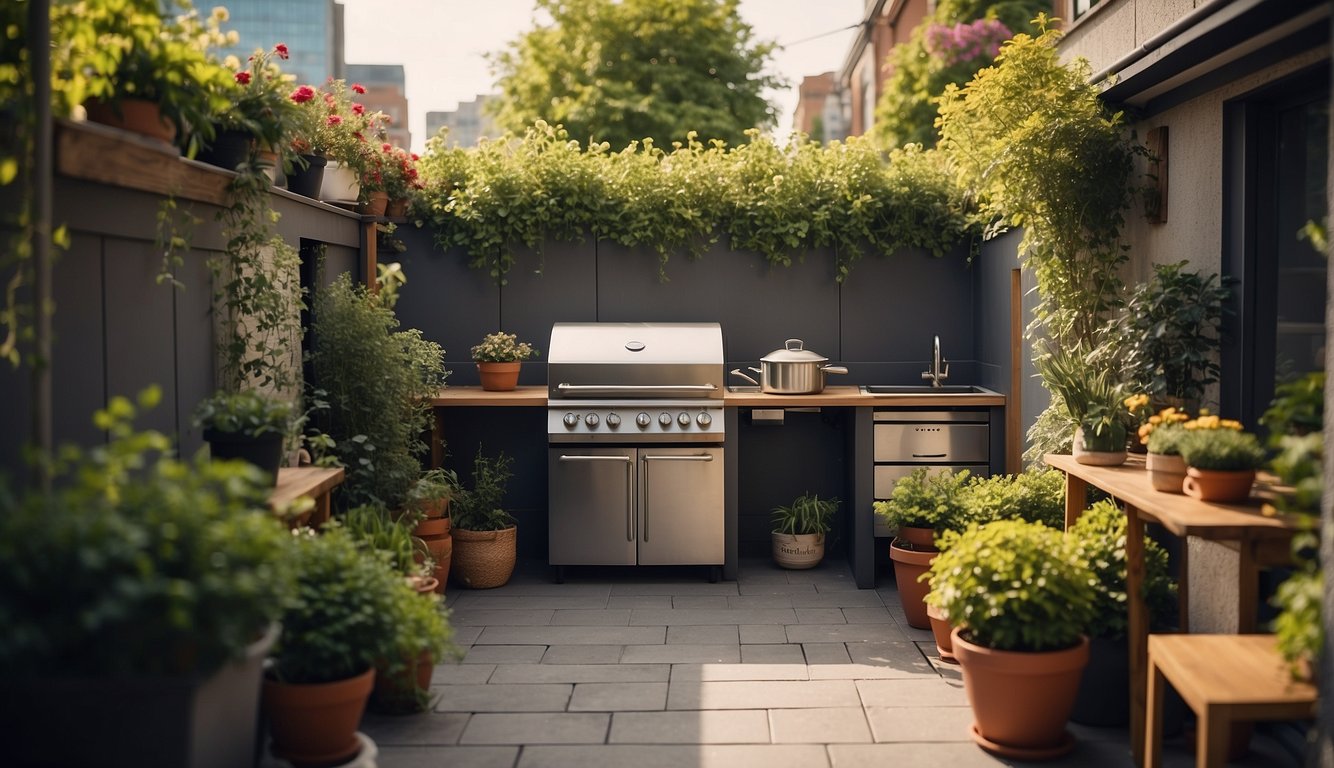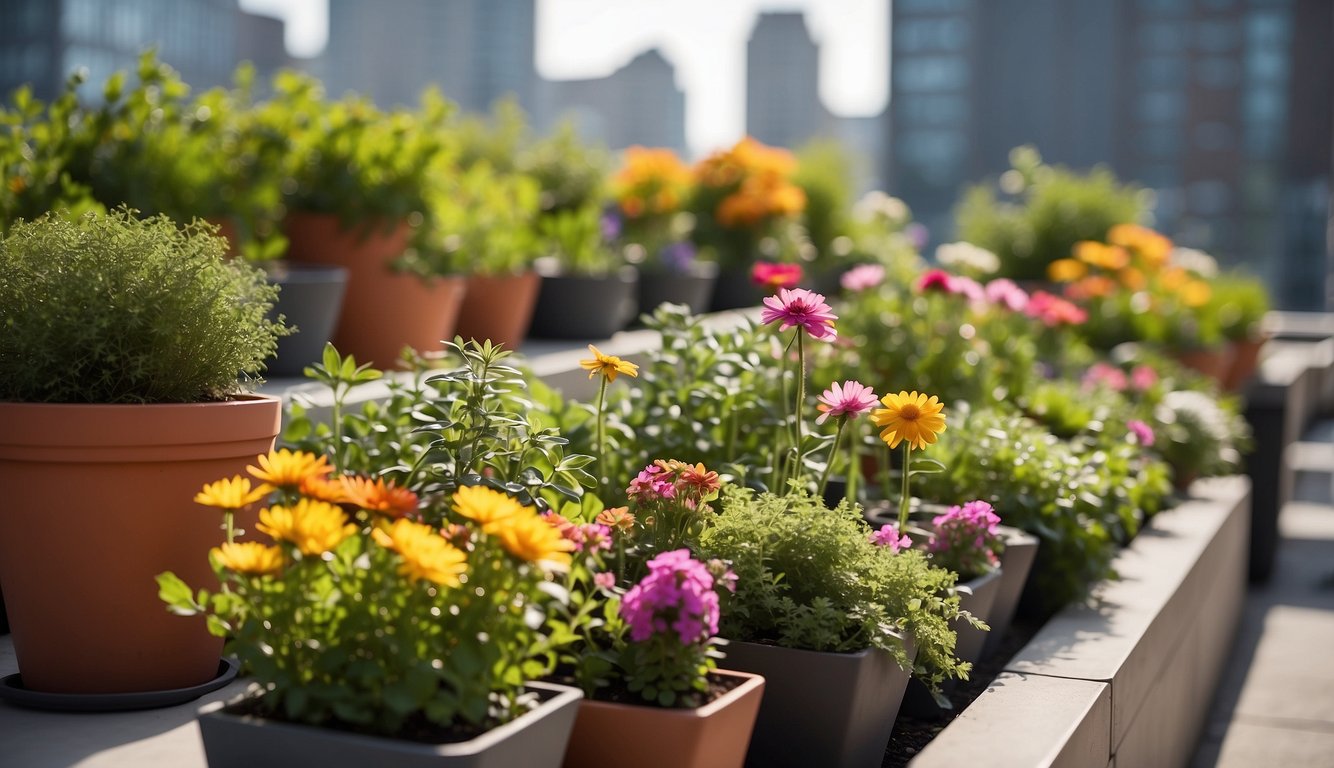Compact rooftop garden designs are a great way to bring nature to urban areas where space is limited. With the right techniques and materials, even the smallest rooftop can be transformed into a green oasis. In this article, we will explore the benefits of rooftop gardens, share some tips for designing your own compact rooftop garden, and provide some gardening techniques to help you maintain your rooftop garden.

Rooftop gardens have become increasingly popular in urban areas due to their many benefits. They help reduce the urban heat island effect, absorb rainwater, and provide a habitat for birds and insects. Rooftop gardens also provide a space for relaxation and outdoor living, which can be hard to come by in urban areas. By adding a rooftop garden to your home or building, you can create a more sustainable and enjoyable living environment.
Table of Contents
Key Takeaways
- Compact rooftop gardens are a great way to bring nature to urban areas.
- Rooftop gardens provide many benefits, including reducing the urban heat island effect and providing a space for relaxation and outdoor living.
- With the right techniques and materials, even the smallest rooftop can be transformed into a green oasis.
Designing Your Rooftop Garden
When it comes to designing your compact rooftop garden, there are a few key factors to consider. In this section, we will discuss how to understand your space and layout, select the right plants and decor, and choose furniture and features that will make your garden functional and beautiful.
Understanding Space and Layout
Before you start designing your rooftop garden, it’s important to understand the space and layout you’re working with. Consider the size and shape of your rooftop, as well as any existing features like walls, stairs, or skylights. You’ll also want to think about the amount of sunlight and shade your rooftop receives throughout the day.
Once you have a good understanding of your space and layout, you can start to plan out your garden design. Consider creating a rough sketch or blueprint of your rooftop, and experiment with different layouts and plant placements until you find the perfect design.
Selecting Plants and Decor
When it comes to selecting plants and decor for your rooftop garden, there are a few things to keep in mind. First, consider the climate and weather conditions in your area, and choose plants that are well-suited to your rooftop environment. You’ll also want to think about the overall aesthetic you want to achieve, and choose plants and decor that complement your design.
Some popular plants for rooftop gardens include succulents, herbs, and small shrubs. You can also add decorative elements like statues, fountains, or trellises to add visual interest and dimension to your garden.
Furniture and Features
Finally, consider adding furniture and features to your rooftop garden to make it functional and comfortable. Depending on the size of your rooftop, you may want to add seating areas, dining tables, or even a small kitchen or bar area.
When choosing furniture and features, think about the materials and durability of each piece. You’ll want to choose materials that can withstand the elements, like sun, wind, and rain. You may also want to consider adding shade structures like umbrellas or awnings to protect your furniture and guests from the sun.
Overall, designing a compact rooftop garden requires careful consideration of space, layout, plants, decor, furniture, and features. By following these tips and working with a professional designer if necessary, you can create a beautiful and functional garden that enhances your rooftop space.
Materials and Maintenance

Choosing Durable Materials
When designing a compact rooftop garden, it is important to choose durable materials that can withstand the elements. We recommend using materials that are lightweight, yet sturdy enough to support the weight of the garden. Wooden decks are a popular choice for rooftop gardens, but they require regular maintenance to prevent rotting and warping. Instead, we suggest using composite decking, which is made from a combination of wood fibers and plastic. This material is weather-resistant and requires minimal upkeep.
In addition to decking, we recommend using lightweight containers made from materials such as fiberglass, plastic, or metal. These materials are durable, weather-resistant, and easy to move around as needed. When selecting containers, be sure to choose ones that are large enough to accommodate the root systems of your plants.
Routine Maintenance Tips
Maintaining a compact rooftop garden requires regular upkeep to ensure the safety of the space and the health of the plants. We recommend performing routine maintenance tasks such as cleaning, pruning, and watering.
To keep your rooftop garden clean, we suggest sweeping or vacuuming the area regularly to remove debris and dirt. This will help prevent slips and falls, as well as keep the space looking tidy.
Pruning is also an important part of rooftop garden maintenance. Regular pruning helps keep plants healthy and encourages growth. Be sure to use sharp pruning shears and cut at a 45-degree angle to prevent damage to the plant.
Finally, watering is essential to the health of your rooftop garden. Be sure to water your plants regularly, but avoid overwatering, as this can lead to root rot and other issues. Consider installing a water feature, such as a drip irrigation system, to make watering easier and more efficient.
By choosing durable materials and performing routine maintenance tasks, you can ensure that your compact rooftop garden is safe, healthy, and beautiful for years to come.
Gardening Techniques
Cultivating a Green Roof
When it comes to compact rooftop garden designs, cultivating a green roof is a great way to maximize space. Green roofs are essentially roofs that are covered in vegetation, and they offer a number of benefits. They can help reduce energy costs, improve air quality, and provide a habitat for birds and insects. To create a green roof, you’ll need to start by ensuring that your roof is strong enough to support the weight of the soil and plants. Talk to a structural engineer if you’re not sure.
Once you’ve confirmed that your roof can support a green roof, you’ll need to choose the right type of plants. Succulents are a great choice for green roofs because they’re low maintenance and drought-resistant. Wildflowers are another good option because they attract pollinators like bees and butterflies. When planting your green roof, be sure to use a lightweight soil mix that won’t put too much weight on your roof. You can also use a layer of gravel or pumice to improve drainage.
Planting for Climate and Wind
When designing a compact rooftop garden, it’s important to consider the climate and wind conditions in your area. If you live in a hot climate, you’ll want to choose plants that can handle the heat. Vegetables like tomatoes and peppers are a good choice because they thrive in warm weather. Herbs like basil and thyme are also a good choice because they don’t require a lot of water.
If you live in a windy area, you’ll need to choose plants that can handle the wind. Look for plants with sturdy stems and deep roots, like flowering plants and shrubs. You can also use windbreaks like trellises and walls to protect your plants from the wind. When planting your rooftop garden, be sure to group plants together based on their water and sun requirements. This will help you avoid over- or under-watering your plants.
Outdoor Living

When it comes to compact rooftop garden designs, creating an outdoor living area is a must. A well-designed outdoor living area can be a great place to entertain guests or simply relax and unwind after a long day. Here are some ideas for creating a functional and stylish outdoor living area on your rooftop garden.
Cooking and Dining
If you enjoy cooking and dining outdoors, consider creating an outdoor kitchen or grill area. An outdoor kitchen can be as simple or as elaborate as you like, depending on your budget and space constraints. Some key features to consider include a built-in grill, a sink, a refrigerator, and plenty of counter space for food prep. You may also want to consider adding a dining table and chairs to your outdoor kitchen area, so you can enjoy meals al fresco with friends and family.
Relaxation and Entertainment
If you prefer to use your rooftop garden as a place to relax and entertain guests, consider creating a cozy seating area. A comfortable outdoor sofa or chairs, paired with some colorful throw pillows and a coffee table, can create a welcoming and inviting space for guests to relax. You may also want to consider adding a fire pit or outdoor heater to your seating area, so you can enjoy your rooftop garden even on cooler evenings.
In addition to a seating area, you may also want to consider adding some entertainment options to your rooftop garden. A small outdoor speaker system can provide music for your guests, while a projector and screen can be used for outdoor movie nights. With a little creativity, you can turn your compact rooftop garden into a functional and stylish outdoor living area that you’ll love spending time in.
Conclusion

In conclusion, we hope that this article has provided you with some inspiration and ideas for creating your own compact rooftop garden. Whether you have a small budget or are looking for a luxury design, there are many ways to make the most of your rooftop space.
When it comes to choosing plants for your rooftop garden, consider using a mix of perennials and annuals that will provide color and interest throughout the year. Succulents and other drought-tolerant plants are also a great choice for rooftop gardens, as they require less watering and maintenance.
If you’re working with a limited budget, consider using recycled materials such as pallets or old containers to create raised beds for your plants. You can also repurpose old furniture or other items to add interest and functionality to your rooftop garden.
For a modern minimalist rooftop garden, consider using simple geometric shapes and clean lines in your design. Use a limited color palette and choose plants that have a simple, sculptural quality.
No matter what your design style or budget, a compact rooftop garden is a great way to make the most of your outdoor space. With a little creativity and planning, you can create a beautiful and functional garden that will provide enjoyment for years to come.
Frequently Asked Questions
How do you maximize space in a small rooftop garden?
Maximizing space in a small rooftop garden requires careful planning and smart design choices. One option is to use vertical gardening techniques, such as trellises, hanging baskets, and wall-mounted planters. Another approach is to use compact plant varieties that take up less space but still produce a high yield. Additionally, incorporating multi-functional elements like seating or storage that can double as planters can help to optimize the available space.
What are the best plants to use for a compact rooftop garden?
The best plants for a compact rooftop garden are those that are well-suited to container gardening and have a shallow root system. Some examples include herbs like basil, thyme, and parsley, as well as vegetables like cherry tomatoes, lettuce, and peppers. Succulents, ornamental grasses, and small flowering shrubs can also add visual interest to a rooftop garden.
What are the key considerations when designing a modern rooftop garden?
When designing a modern rooftop garden, it’s important to consider factors like the overall aesthetic, the function of the space, and the environmental conditions. Using sleek, minimalist design elements and incorporating sustainable features like rainwater harvesting or solar panels can help to create a modern, eco-friendly rooftop garden. Additionally, selecting plants that are well-suited to the local climate and microclimate of the rooftop can help to ensure their success.
How can one start a vegetable garden on a rooftop?
Starting a vegetable garden on a rooftop requires careful planning and preparation. It’s important to assess the structural integrity of the roof and ensure that it can support the weight of the garden. Next, selecting the right containers, soil, and plants is crucial for success. Providing adequate drainage, water, and nutrients is also important. Finally, regular maintenance and monitoring can help to ensure the health of the plants and the success of the garden.
What are the common challenges faced when maintaining a rooftop garden?
Maintaining a rooftop garden can present some unique challenges, including exposure to wind, sun, and extreme temperatures. Watering and fertilizing can also be more difficult due to limited access to water sources and the need to carry supplies up to the roof. Pests and diseases can also be a concern, as can the potential for damage to the roof or surrounding structures.
How can you ensure safety and structural integrity in rooftop garden designs?
Ensuring safety and structural integrity in rooftop garden designs requires careful planning and consultation with experts. Assessing the load-bearing capacity of the roof and ensuring that it is properly reinforced is crucial for safety. Additionally, selecting containers and plants that are well-suited to the rooftop environment can help to prevent damage to the roof and surrounding structures. Regular maintenance and monitoring can also help to ensure the ongoing safety and success of the rooftop garden.


